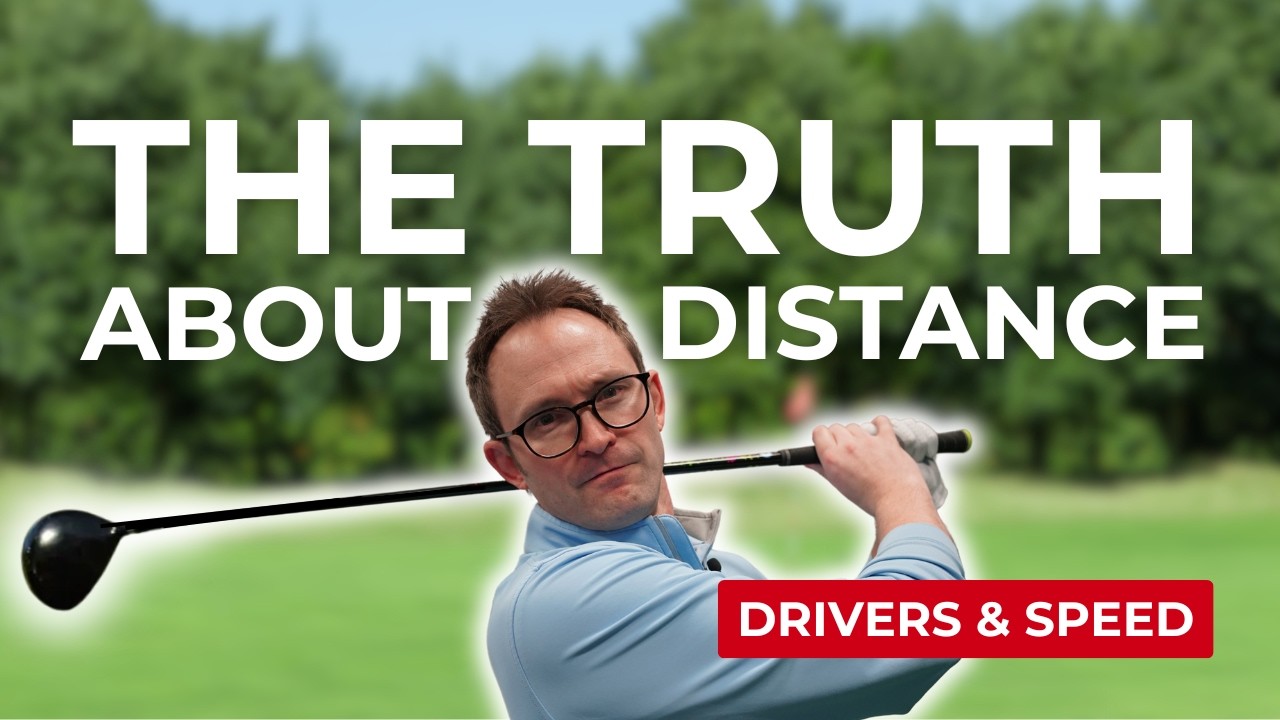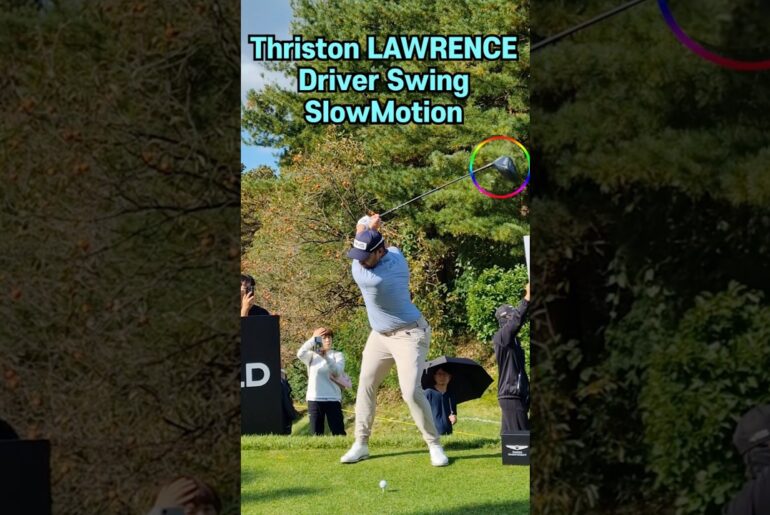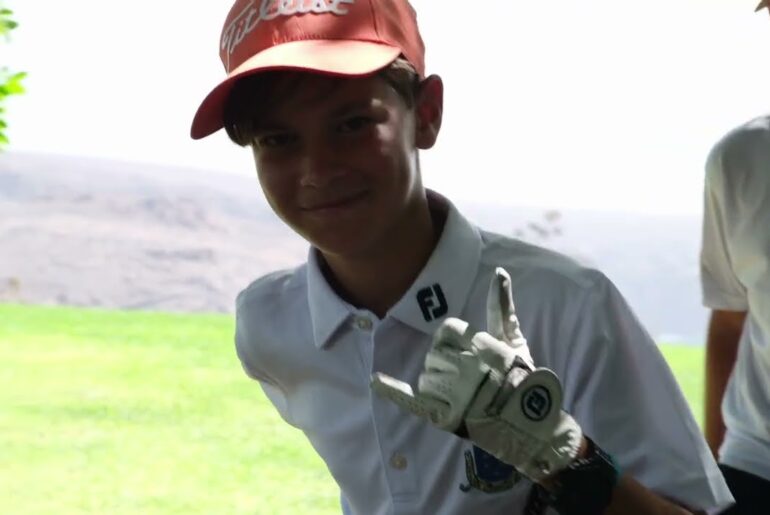One of the most common questions in golf is how far you should be hitting your driver. We show you what yardage is realistic depending on your swing speed and what to improve to hit longer drives.
We hit shots at moderate to high club speeds to give you an indication of realistic carry and total distance ceilings. We also break down how optimum spin and launch angle will change depending on speed, and what you need to do to unlock maximum distance possible from your swing.
Ultimately this will help you strategise on the course, and show you whether you’ll really get over that 250 yard bunker…
00:00 How Far Should You be Hitting Your Driver?
00:53 Hitting at 80mph Club Head Speed
03:55 Hitting at 90mph Club Head Speed
05:47 Hitting at 100mph Club Head Speed
07:45 Hitting at 110mph Club Head Speed
10:10 What Distance is Achievable Based on Each Club Speed?
BOOK YOUR DRIVER FITTING TODAY
WORK ON YOUR CLUB SPEED WITH OUR EUROPEAN TOUR LEVEL COACHING
LEARN MORE ABOUT OUR PRECISION FITTING SERVICES
Want to see more technique and equipment explanations from our expert fitters? Subscribe to our channel here: http://www.youtube.com/@Precision_Golf?sub_confirmation=1
#improveyourgolf #golfdriver #swingspeed #golfdrive #averagegolfer #golftips #golftipsdaily #golflife #golfdistance
So, one of the things that we get asked in the fitting bays the most often is how far should I be hitting my driver? So, based on club speed alone, and we’re going to try and keep angle of attack as neutral as possible, we’re going to give four indications 80, 90, 100, and if I can muster 110 mph club speed to give you a range of speed to say, right, based on club speed and so therefore input, what is the potential distance for you at that speed? So, I’m going to try and keep angle of attack pretty neutral rather than go four or five up or two or three down. Keep it kind of around the one degree mark if I can. Um, but just to give an indication so you can have an understanding of what actually is physically doable at that speed. You know, sometimes the expectations for what can be gained can be a little outside of the parameters that are physically achievable. So, you can use this as a benchmark as to how far you should be hitting your driver. So, we’re going to start at 80 mph and then we’ll gradually work the speed up uh and really look at say what are the yardages in terms of carry and total that are doable. But we’ll go through a summary at the end and look at what needs to change in terms of parameters to hit those optimal numbers too. See where that club speed goes. 83. So, a little bit strong, but we can see from there ball flight that’s quite low. So, I’ve got to bring that flight up in order to hit the optimal carry in particular. So, let’s add a little bit of loft through impact. So, a bit more flight, 81 mph, still quite low spin. So, and this is where in a fitting we’d be looking at the equipment itself to, you know, get a bit of launch and spin out of this to get that carry up. So, it’s just dipping out the air. The total’s good, but losing carry because the spin’s down. So, I’m going to give it a another one or two just to see if I can get all of those dialed in as best as possible. Okay, we’re still quite low spin. So for me with this club, I’m going to have to hit a bit of a cut to try and get the spin on the flight to get the ball in the air. And you might think that sounds a little bit strange. Now, surely a draw always goes further. Um, so if I was in a fitting at this point, we’d be looking at different loft head to get that flight up. But to get the spin with this club setup, I’ve got to generate it through getting a bit out in and opening the face up. say the opposite of what most people would think would get optimum numbers, but just shows what an inappropriate club at this speed does and what I’ve got to do to get the flight on it. So, cut across that a little bit. Got more spin onto it. So, you know, up goes the spin. It’s a bit less efficient as a flight, but we’ve now got near the well, it’s a little bit lacking. We can get a little bit more from that club speed went up slightly. Let’s give that one more go. 18 13 launch. So still set a little bit at the bottom of it. But what we can see there in terms of actual kind of total distance on it is it runs out well because the flight’s a bit low. You lose a bit of carry. But as the numbers on the screen show, you can get pushing one 180 carry 200 total. Uh so as we move up the speeds, the drive will become more appropriate for that level. I won’t have to manipulate the flight quite as much. I don’t want to change angle of attack hugely, which is why I haven’t really sat behind and scooped it up. But I’m going to move up 10 mph now. Uh and then we’ll see where the numbers have got to be and what’s possible given that 10 mph extra input. Right, let’s take speed up 10 mph. Let’s get to 90. and see where we where we get to there 32 89. So yeah, distance-wise, you 10 10 mph in club speed should lead to about 15 mph in ball speed. It’s not quite 2 yards per mile an hour, but we should be looking around the 30 m 30 m. Wouldn’t that be nice? 30 yards extra at the 10 mph more club speed. So, let’s do a couple more. That’s still a little bit flat in flight. So, where I’ve got to take speed down, that you generate less friction on the ball, generate less spin. So, it’s actually a little bit flat in terms of flight. So, again, I’ve got to pick that launch angle up to get the carry, which for that last shot was sat 14 yards under optimal. So, again, I’ll put a bit more flight on this, trying not to get the club speed up much. So, I’ve got to work that under and scoop it a bit. So, I’ve added a load of flight there, and that’s got the carry right up. So, it’s at just under 90 miles an hour. I’ll give that another one there. But, you know, we’re looking at launch angles up at 15° spin mid 2000s. And this is the danger if you go to low spin runs out, but if you go too low, you lose carry. Uh, and carry gives you consistent distance, which ultimately is what we all want. It’s got a bit more flight on it. So yeah, so those last two that’s set a couple of miles an hour under, but we’re into that optimal setup in terms of launch and spin. So little easier for me to generate that moving the speed up slightly. Um, but again, you can see the importance at the lower speeds, the more moderate speeds, keeping that launch angle up. So let’s take it up another 10 mph. Right, so up another 10. Let’s go to 100 miles an hour. See, so we’ve gone from 200 to 230, 235 at 90 mph. What can we get at 100 miles an hour? So here again, we’ve got we’re still looking at the same incremental uh jump between each drop. We’re going 10 miles an hour each each jump. So it’s 15 mph ball speed. So we should be another 30 odd yards. Now actually uh it it goes up a little bit more than that. It is slightly more exponential in terms of distance gain uh as you go up in club speed. So you what we’re seeing here is your potential looking at 270. Now this one’s been low spin, so it’s really run, but um and again, you’re looking at carry, we’re a couple of yards under on carry. But what we’re starting to see, I’ll go through this after the next batch, is a trend of how important spin is at different speeds versus launch angle and and getting the height. You really important to moderate speeds. As the club speed and ball speed goes up, the spin keeping it in the air is less important, but you stand a bit more to gain on the run out on a stronger spin rate. So, let’s give that another another couple. Let’s bang on 100 miles an hour. So, yeah. So, a little bit more flight there. I’ll I’ll quit on that one cuz that’s a really straight line across the optimal. I’ve got a little bit more spin, a little more flight, which has then got the carry distance. So, ironically, less total. So, the low spin runs out further. Uh, and that’s always been one of the questions is, well, isn’t isn’t low spin good to a point, but it can make a flight volatile. So, that sort of mid twos on spins very very safe from a ball flight point of view as you hit the 100 mph, 270 is a top out. Now, I’ve got to try and get the 110. Wish me luck. So, I’m going to attempt to get to 110. That’s right on my upper limit from a speed point of view. And, uh, if you’ve watched this video, uh, I won’t be using the smelling salts unlike I did in that one. But, let’s see what I can get up to. I can get to 110. See where that takes us from a top out point of view. Now, one of the things that will happen if I’m trying to really push the limits on my speed is my my technique, my strike’s going to go off a little bit. So normally my cruising speed on course is about 107 108 and so it’s whether the extra effort actually gets me the extra speed but if I can get to 110 I will certainly do so. Debatable though it’s going to be fairly close. Yeah. So 108 108 and 1/2 decent ball speed 161 12. So, we’re now seeing two and a half thousand of sits on the upper end of the spin window. So, where we needed that just to keep the thing in the air at moderate speeds, it’s now actually risking losing me a little bit of distance uh at this kind of ball speed. Let’s see if I can get that back down a little bit, but the importance of spin, higher spin, it hurts you the higher your speed is. Now, a lot of the tour players will will sit at about 2 and a half thousand revs because it means it’s safe. It’s a little bit safer ball flight. it can’t knuckle out the air. They know what the ball’s going to do when it lands. It’s consistent from a carry point of view. It’s great. And they’re more interested in that because it’s reliable yardage. Uh yeah, you could lasso like on that shot, I could lasso another 10 yards out of knuckling the spin down, but it can start to get the the ball flight a little bit in and out and and volatile, but low spin at high speeds equals distance. little bit strong again there. I think that’s probably about as good as I’m going to get. So, whilst it’s a mile an hour off, we’re still right up at that that top end ceiling. So, let’s look at the averages on those and really highlight just what I’ve had to do with my own club to hit optimal flights with each with each swing speed change and why it’s so important to get that club right for you rather than having to find a shot that works for you. But let’s have a little dive into the numbers now and check out what what makes sense and what’s possible at each speed. So going through at each speed what is optimal. So you we’re at 81 and a half here. So it’s a hair above but uh you know maximum in terms of smash factor. Now this was the one I was struggling to get the flight. So what I’m going to do is I’m going to click onto the optimizer here. And this screen shows you where I’m actually losing out a little bit. You so because the flight’s on the bottom end here. Uh ball speed’s great, but I’m not quite getting the ball flight I want. We’ve lost 10 yards of carry. So, actually total’s good. It’s run out well, which in the UK where we’ve got slightly firmer turf. Uh you can use the ground a little bit more if you’re prepared to give up a bit of carry. You can make it up and possibly even more than make it up uh along the ground with a flatter flight. So, links for example. But if you’re, you know, 40% of our viewers are in the US, if you play overseed, if it’s carry based, if it’s softer turf, you’ve got to get that launch angle up. Otherwise, you’re just giving up carry distance. And if I optimize it based on just carry, again, we can see here how low that sits. So, we really need to get that launch angle up to get maximum carry distance at moderate speeds. Um, you know, down at 80 mph. Yeah. 85 carry 205 207 total is certainly in the tank for 80 or just over 80 mph. If I switch 10 mph up, what we can see here is it’s been easier for me to generate the launch and get the flight. So spin sits at the bottom end of the optimal uh area there, but I’ve got launch angle now. So we’re now at a point where height’s in a good place. We’re now got the carry up. So you’re then looking at for that extra 10 mph optimal carry at 80 was 185. We’re now at 210. So quite a significant shift up in distance there by going up those 10 mph in club speed. You know total sits at 230 just over 230. Um so you know again that height launch angle at this is still really critical uh to getting that carried in. So we need some spin to keep the ball in the air. Drop too much spin it’ll fall out the sky. But, you know, at 90 mph, you know, 230 with moderate run out conditions, certainly 205, 210 carry, certainly achievable. Take it up another 10 mph at 100 100 miles an hour club speed, you know, which is starting to get on the stronger end for amateur golfers. You know, you’re now looking at 270 from a total distance point of view and pushing nearly 250 from a carry point of view. So again, we’re seeing that that carriage is going up, you know, 20 30 yards each time. As we predicted from a ball speed point of view, if you gauge it on 2 m hour per 2 yards per mile an hour ball speed, we’re gaining 15 mph ball speed each jump of 10 mph club speed. There’s your 30 yards. So we’re now starting to get into really significant distances uh and really kind of strong distances for amateur golfers. So a lot of bunkers sat at 250. So if you’re not over 100 miles an hour and you’ve got a 250 carry to make, unless you really sit behind it, launch it high and create a very kind of high loopy ball flight, you’re not going to make that carry distance. So around strategizing, this starts to become really, really, really key at all swing speeds to know, right, if I’ve got a bunker or a ditch um or a quarter to carry, you know, what is physically achievable. So you can see 100 milesPH just about 250 but not quite you know 207 210. So actually the carry distance has jumped up even more actually from 90 to 100. Um and you know looking at then a 25 25 yard gap down at 90 down 80 miles an hour sorry. So you know it starts to ramp up quite quickly as you go up in speed. But we can see here again we’re still in that same mid twos in terms of spin. That’s absolutely fine. move up to nearly 110 mph club speed. Well, that 2 and a half thousand rev spin would sit right on the upper end of that. So, the the more your ball speed goes up, the more important that spin comes down a certain amount in order to keep that ball flight going forwards and give you maximum distance. But at 110, well, you know, I’m one m hour off. 300 certainly doable. Um, you know, pushing 280 in terms of carry, you know, 275 certainly doable. Uh but again, a lot of bunkers, a lot of corners, a lot of trees, a lot of trouble. Uh you know, knowing what you can and can’t do physically within within your limits is so key to strategizing. But as you can see, that that distance really starts to ramp up. But unless you are nearly 110 miles an hour, unless you’re on rock hard fairways, 300 is not achievable. So part of what this is this test today is a case of saying okay well what are expectations versus reality for a lot of golfers you we all remember our best hit our best drive our longest shot it’s downwind down hills firm fairways you know this is gauged on very much springtime fairways of you mid to mid to soft fairways so it’s not hard runouts so these are all genuinely achievable yardages if you’re on and around these club speeds to gauge but most importantly to get a kind of look at really from a strategy core point of view. What should or could I be able to make in terms of carry distances and what is my kind of ceiling in terms of runout distance to know you is there a corner you can take on or should you rain it back and take the three-wood out and just make a decision just to play back a little further because you can actually hit it further than you might believe. Ultimately, you know, the uh you know, the key thing to this is technique and the right club will ensure that you’re not having to manipulate your swing in order to find that flight. At the lower speeds, I really had to try and gain height. You cut across it and open the face up to get enough lift and get enough spin. So, if you play too little loft at moderate speeds, it really compromises. You know, an 8° driver at 110 mph for me, perfectly suitable. So you play a little too much loft at high speeds, you lose a load of distance because it stalls up and dies. You play too little loft at moderate speeds and you’re really struggling to get the ball up in the air and carrying. So make sure that you’ve got the club that’s appropriate for the ball flight that you need at your speed. And then all of these numbers are perfectly achievable. [Music]








34 Comments
One of the better and most informative videos I’ve seen on here in awhile.
You don't open by mentioning the loft of the driver you are using.
This is where changing balls may help to something that's either softer to harder on compression to help get more distance presumably?
Thank you!!
Would love to have seen the 80 and 90 numbers generated with a more appropriate lofted head.
Keep having this argument with one of the guys in our group where your ball initially lands is how far you have hit it not where it has rolled out to
Great video! I had been wondering for a long time if I had the right driver shaft scaled with my ball speed. My launch monitor has me around 150 mph ball speed on a good strike. No club speed data. With a regular flex shaft I find it hard to control the face/path/flight. Seems to require alot of timing and heavy in to out path to find fairways at my full swing speed. Might be time for a driver shaft fitting.
Great video! I got fit a Precision golf previously for my driver and was swinging it in and around 90mph. I have since gained some speed between 95-100mph. Do you think it is worth coming back for a tune up/review as I think I am only hitting it 225 carry with a high spin rate?
Another great informative video.
Numbers tally up to what I was getting during our fit 😁👍🏾
On a separate note, what is the name of the video on your channel where by you fit yourself for your current driver. Wouldn't mind re-watching it now I'm armed with abit more fitting knowledge 😅
Simon, excellent demonstration and explanation of driver carry and total distance based on swing speeds. I have a 95 mph swing speed, so my carry should be around 230 yards. I’m not all that concerned about total distance because that will change based on course conditions. Cheers.
I heard somewhere that total distance should be 2.7 yards per 1 mph swing speed. Now I need to measure my swing speed.
Really interesting video – as a 89-90 swing speed, my numbers are in line with what you showed here – the disappointing thing is that I cannot seem to get anything extra despite trying to get faster …!
Ian Fraser uses 2.7 X club speed to get a good distance number which was dead on for your 100 mph swing and close for the others.
Nice 👍🏻
Kindly delete the first 50 seconds and just get straight to the point.
Interesting analysis. The optimal launch angle window didn't seem to vary much by swing speed, which surprised me.
Very Very interesting, 90mph SS carries further than my 98pmh SS 148/150 BS .I really need to go for a fitting where there are a plethora of shafts because this Project X VRFT just is not helping.
Ping have a great chart with launch ,spin and swing speed for optimal numbers
Superb video, answers a lot of questions and where to look to change things?
Great video and appreciate giving normal speed metrics for the normal golfer!
Oh, to swing it at 100 and have it look like an easy iron approach.🤔
Really enjoy your "professorial" manner, Simon.
Great video on distance. Can you help me by telling me what you think is the best counterbalanced hybrid shaft. I have VA Synystr CB in my Driver and fairways I have a stiff 55g shaft in driver and 65g in fairways. Recommendation?
Really interesting, was amazed at how slow your swing looked a 80 & 90. My take is I am trying to swing too fast! Thanks…
How far above sea level did you set this to?
Good info here, but I’ll add that at 110 swing speed… the numbers here show by just raising your attack angle you can get even more carry and total distance. With an attack angle of +5° to 8° will dramatically add distance with the same swing speed. You could further and choose a ball that will increase ball speed at 110mph swing speed. You could go even further, and drop total weight of the driver and gain about an extra 10mph of swing speed. You can go even further and choose a lite shaft that has more flex and lower torque, to add stable clubspeed. All of a sudden, your total swing speed will go up with same effort, and you are carrying well over 300 yards.
Why not use drivers more suited to the swing speed for demonstration purpose’s?
Embarrassing is when you have sick Callaway Elyte driver, Graphite Designs UB60TX shaft & blessed with 116-118mph swing speed but I can only carry 265-280y 😂. But then again only played golf since turning 50yo 6 months ago so the SF is not upper 140's hahah more coaching. I hate my buddies that have played forever "must be nice to have speed" yeah sure until you hit a 165mph ball speed left handed slice 🤦🏻 you think your slice goes off line? Haha
I feel like I hit around 90mph but barely roll out to 190 yards on a real course. Of course in a simulator my 90mph speed translates to 230 yards roll out. Go figure
I swish my driver at 95mph how far should I hit it
You really need to match club loft and shaft weight with the different speeds. You can get a quite a bit farther with an 80 MPH head speed if you have a 12 loft and soft shaft, like about 190-200 carry. Reduced loft is for faster head speeds to reduce spin, increasing penetration, and so energy isn't lost with too high a launch angle, but for slower head speeds, there is less friction from air due to less ball speed therefore less magnus effect. Increased head loft and lift from soft shaft keep the ball in the air longer and give slower swings additional distance by increasing magnus effect.
I, on average, trackman, have swingspeed of about 104. Varies, on trackman indoors, between 102 and 108. My max carry on course (real measurement) is about 260 yards. I almost never see players hit it past me. So i assume very much bragging in the internet is bullshit and only maybe 5% of amateurs really hit over 260 yards carry.
A lot of misconception is due to on course distance markers though, i guess. They are way off, tee to green, from reality many times.
I average 340 yards with club speed of 125mph im single handicap player age 52 . Playing golf since 5 years old . For people with faster swing speeds but spin and smash factor needs be right to not just swing as fast as you can .Core strength and timing technique need be there too not just pure speed. I can swing faster but accuracy goes starrt pulling and pushing a bit but when connect yup it goes further. Drove pin high on local course par 4 with 368 yards to pin . Obviously ground conditions and wind also play a part .
This is an EXCELLENT video – nothing but useful and accurate information.
Hit my 3,5,7 better than my driver. Average around 250/260 wood, 225-235 5 wood @88 mph, 208-214 with a similar speed feel 7 wood. My driver I don't hit much, I am erratic and trying new drivers again. Ave 97-110 speed and range from 250-309. I tend to hit my 3 off the tee when I struggle. Still out there with the other guys most days.
I swing at 98-101 mph with a driver and don't get anywhere near these numbers…..